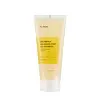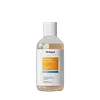What's inside
What's inside
 Key Ingredients
Key Ingredients

No key ingredients
 Benefits
Benefits

 Concerns
Concerns

 Ingredients Side-by-side
Ingredients Side-by-side

Water
Skin ConditioningSodium C14-16 Olefin Sulfonate
CleansingGlycerin
HumectantCocamidopropyl Hydroxysultaine
CleansingSodium Cocoyl Glycinate
CleansingAcrylates Copolymer
Lauryl Glucoside
CleansingPropylene Glycol Laurate
Skin ConditioningCalendula Officinalis Flower Extract
MaskingCalendula Officinalis Flower
Skin ConditioningLactobacillus/Hibiscus Sabdariffa Flower Ferment Filtrate
Skin ConditioningChamaecyparis Obtusa Leaf Extract
Skin ConditioningMelaleuca Alternifolia Leaf Extract
PerfumingMentha Suaveolens Leaf Extract
AstringentTrifolium Pratense Extract
Skin ConditioningCentella Asiatica Extract
CleansingBeta-Glucan
Skin ConditioningRosmarinus Officinalis Extract
AntimicrobialSolanum Lycopersicum Fruit Extract
AntioxidantCoffea Arabica Seed Extract
MaskingSerenoa Serrulata Fruit Extract
Skin ConditioningMalus Domestica Fruit Extract
AntioxidantMentha Rotundifolia Leaf Extract
TonicCamellia Sinensis Leaf Extract
AntimicrobialThymus Vulgaris Leaf Extract
Skin ProtectingCynanchum Atratum Extract
Skin ConditioningHyaluronic Acid
HumectantHydrolyzed Hyaluronic Acid
HumectantHydrolyzed Sodium Hyaluronate
Skin ConditioningHydroxypropyltrimonium Hyaluronate
Potassium Hyaluronate
Skin ConditioningSodium Hyaluronate Crosspolymer
HumectantSodium Acetylated Hyaluronate
HumectantDecyl Glucoside
CleansingMethylpropanediol
Solvent1,2-Hexanediol
Skin ConditioningCoco-Glucoside
CleansingSodium Chloride
MaskingTromethamine
BufferingCitric Acid
BufferingPanthenol
Skin ConditioningCaprylhydroxamic Acid
Ethylhexylglycerin
Skin ConditioningAllantoin
Skin ConditioningDisodium EDTA
Pentylene Glycol
Skin ConditioningPropanediol
SolventButylene Glycol
HumectantEctoin
Skin ConditioningAcacia Senegal Gum
MaskingLactic Acid
BufferingSalicylic Acid
MaskingGluconolactone
Skin ConditioningGlycolipids
Skin ConditioningCaprylic/Capric Triglyceride
MaskingTocopherol
AntioxidantAscorbic Acid
AntioxidantSodium Carbonate
BufferingSodium Hyaluronate
HumectantCapryloyl Salicylic Acid
ExfoliatingXanthophylls
Skin ConditioningWater, Sodium C14-16 Olefin Sulfonate, Glycerin, Cocamidopropyl Hydroxysultaine, Sodium Cocoyl Glycinate, Acrylates Copolymer, Lauryl Glucoside, Propylene Glycol Laurate, Calendula Officinalis Flower Extract, Calendula Officinalis Flower, Lactobacillus/Hibiscus Sabdariffa Flower Ferment Filtrate, Chamaecyparis Obtusa Leaf Extract, Melaleuca Alternifolia Leaf Extract, Mentha Suaveolens Leaf Extract, Trifolium Pratense Extract, Centella Asiatica Extract, Beta-Glucan, Rosmarinus Officinalis Extract, Solanum Lycopersicum Fruit Extract, Coffea Arabica Seed Extract, Serenoa Serrulata Fruit Extract, Malus Domestica Fruit Extract, Mentha Rotundifolia Leaf Extract, Camellia Sinensis Leaf Extract, Thymus Vulgaris Leaf Extract, Cynanchum Atratum Extract, Hyaluronic Acid, Hydrolyzed Hyaluronic Acid, Hydrolyzed Sodium Hyaluronate, Hydroxypropyltrimonium Hyaluronate, Potassium Hyaluronate, Sodium Hyaluronate Crosspolymer, Sodium Acetylated Hyaluronate, Decyl Glucoside, Methylpropanediol, 1,2-Hexanediol, Coco-Glucoside, Sodium Chloride, Tromethamine, Citric Acid, Panthenol, Caprylhydroxamic Acid, Ethylhexylglycerin, Allantoin, Disodium EDTA, Pentylene Glycol, Propanediol, Butylene Glycol, Ectoin, Acacia Senegal Gum, Lactic Acid, Salicylic Acid, Gluconolactone, Glycolipids, Caprylic/Capric Triglyceride, Tocopherol, Ascorbic Acid, Sodium Carbonate, Sodium Hyaluronate, Capryloyl Salicylic Acid, Xanthophylls
Water
Skin ConditioningCocamidopropyl Betaine
CleansingSodium Lauroyl Methyl Isethionate
CleansingDecyl Glucoside
CleansingCoco-Glucoside
CleansingGlyceryl Oleate
EmollientVaccinium Myrtillus Fruit/Leaf Extract
AstringentSaccharum Officinarum Extract
MoisturisingCitrus Aurantium Dulcis Fruit Extract
MaskingCitrus Limon Fruit Extract
MaskingAcer Saccharum Extract
Skin ConditioningBetaine
HumectantPEG-120 Methyl Glucose Dioleate
EmulsifyingGlycerin
HumectantSodium Benzoate
MaskingPotassium Sorbate
PreservativeSodium Benzotriazolyl Butylphenol Sulfonate
UV AbsorberButeth-3
SolventTributyl Citrate
SolventDisodium EDTA
Parfum
MaskingCI 19140
Cosmetic ColorantCI 45100
Cosmetic ColorantWater, Cocamidopropyl Betaine, Sodium Lauroyl Methyl Isethionate, Decyl Glucoside, Coco-Glucoside, Glyceryl Oleate, Vaccinium Myrtillus Fruit/Leaf Extract, Saccharum Officinarum Extract, Citrus Aurantium Dulcis Fruit Extract, Citrus Limon Fruit Extract, Acer Saccharum Extract, Betaine, PEG-120 Methyl Glucose Dioleate, Glycerin, Sodium Benzoate, Potassium Sorbate, Sodium Benzotriazolyl Butylphenol Sulfonate, Buteth-3, Tributyl Citrate, Disodium EDTA, Parfum, CI 19140, CI 45100
 Reviews
Reviews

Ingredients Explained
These ingredients are found in both products.
Ingredients higher up in an ingredient list are typically present in a larger amount.
Coco-Glucoside is a surfactant, or a cleansing ingredient. It is made from glucose and coconut oil.
Surfactants help gather dirt, oil, and other pollutants from your skin to be rinsed away.
This ingredient is considered gentle and non-comedogenic. However, it may still be irritating for some.
Learn more about Coco-GlucosideDecyl Glucoside is a glucose-based surfactant and emulsion stabilizer. It is created by reacting glucose with the fatty acids from plants.
Surfactants help clean the skin by trapping oil, sebum, and dirt to be washed away. As an emulsion stabilizer, it stabilizes the ingredients in a product by preventing them from separating.
This ingredient is biodegradable and non-toxic. This ingredient is commonly found in baby shampoos.
Decyl Glucoside is sometimes used to stabilize the UV filter Tinosorb.
Learn more about Decyl GlucosideDisodium EDTA plays a role in making products more stable by aiding other preservatives.
It is a chelating agent, meaning it neutralizes metal ions that may be found in a product.
Disodium EDTA is a salt of edetic acid and is found to be safe in cosmetic ingredients.
Learn more about Disodium EDTAGlycerin is already naturally found in your skin. It helps moisturize and protect your skin.
A study from 2016 found glycerin to be more effective as a humectant than AHAs and hyaluronic acid.
As a humectant, it helps the skin stay hydrated by pulling moisture to your skin. The low molecular weight of glycerin allows it to pull moisture into the deeper layers of your skin.
Hydrated skin improves your skin barrier; Your skin barrier helps protect against irritants and bacteria.
Glycerin has also been found to have antimicrobial and antiviral properties. Due to these properties, glycerin is often used in wound and burn treatments.
In cosmetics, glycerin is usually derived from plants such as soybean or palm. However, it can also be sourced from animals, such as tallow or animal fat.
This ingredient is organic, colorless, odorless, and non-toxic.
Glycerin is the name for this ingredient in American English. British English uses Glycerol/Glycerine.
Learn more about GlycerinWater. It's the most common cosmetic ingredient of all. You'll usually see it at the top of ingredient lists, meaning that it makes up the largest part of the product.
So why is it so popular? Water most often acts as a solvent - this means that it helps dissolve other ingredients into the formulation.
You'll also recognize water as that liquid we all need to stay alive. If you see this, drink a glass of water. Stay hydrated!
Learn more about Water